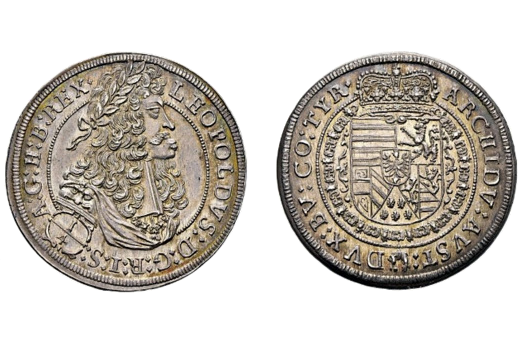
about ancient nomos
Ancient Nomos Art is a museum of galleries exhibiting ancient coins and ancient mint maps. The coin gallery displays the diverse art and history of hand-crafted ancient Greek, Roman, Byzantine, Persian and Medieval coinage. The ancient mints mapping gallery features Greek, Roman, Byzantine, Asia Minor and Medieval mint city regions and territories. Visitor's are welcome to explore, study and enjoy Ancient Nomos Art.

Post-Medieval Austria – 1691 AD
Emperor Leopold I
From Ancient Galleries

Obverse: Baroque bust of Leopold I laureate and cuirassed facing right, wearing the Order of the Golden Fleece.
Reverse: Crowned imperial coat-of-arms within the Order of the Golden Fleece.
LEGENDS
Obv: LEOPOLDVS : D : G : ROM : IMP : SE : A : G : H : B : REX •, bust of Leopold I laureate and cuirassed facing right, wearing the Order of the Golden Fleece; ¼ denomination below right shoulder and under a gargoyle. Rev: ARCHID : AVST : DVX : BV : COM TYR •, crowned imperial coat-of-arms within the Order of the Golden Fleece.
The post-medieval coins Austria, during the late phase of the Holy Roman Empire under Leopold I (1657-1705 AD), are truly marvelous miniature works of art. Since portraits of prominent individuals have graced coins for millennia, images forged in precious metals in the distant past can represent disease even now. Indeed, the earliest artistic depictions of disorders such as goiter and trichoepithelioma were on ancient Greek, Roman, and Parthian coins. This brings us to the above Leopold 1/4 taler. Leopold I was a defining figure in the history of the Habsburg dynasty. His reign saw the consolidation of the Monarchy after the Thirty Years’ War and the decisive victories against the Ottoman Empire that enabled the Habsburg Monarchy to become one of the leading Great Powers in Europe. Leopold himself was however a shy, indecisive character who effaced himself behind his imperial persona. He was not a ‘radiant’ monarch, being almost grotesquely ugly and afflicted with an extreme example of the Habsburg jaw. According to Craig Blackstone MD, Extreme mandibular prognathism can be seen in Holy Roman Emperor Leopold I (1640-1705), whose profile dominates the illustrated silver Austrian 3 Kreuzer coin of 1670. In fact, this image contributed to his unflattering moniker ‘Leopold the Hogmouth.’ The humped nose (‘Habsburg nose’) and enlarged lower lip (‘Habsburg lip’) are also evident. On coins of later dates, these traits become more prominent for Leopold and other Habsburgs. Blackstone continues, “clearly visible facial anomalies did not seem troubling to them, since the ruling Habsburgs could have easily ensured that these were not emphasized on contemporary coins and paintings.”
DOCUMENTATION
Value: 1/4 Taler. Metal: AR Silver. Weight: 7.16 grams. Mint: Hall (Tryol). Date: Undated, struck 1691-92 AD.
Attribution: Moser and Tursky 765; Herinek 863; Künker 127, 4300; Ex. Annemarie und Gerd Köhlmoos Collection Numismatic Rarities and Masterpieces, 1429 (this coin).
Legend, Documentation and Attribution
